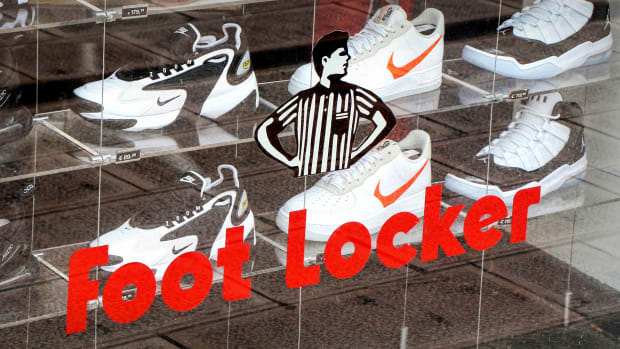
Since taking over Foot Locker Inc. (FL) last year, CEO Mary Dillon has had to walk a tricky line with the company’s most important customer: Nike Inc. (NKE)
And that line is just how important Nike should be to Foot Locker. The two companies have historically been close: Last year, Nike accounted for 70% of Foot Locker’s total annual revenue.
But the relationship started to crack a few years ago when Nike started to focus more on selling its apparel and footwear directly to consumers, which of course hurt Foot Locker.
Under “Lace Up” strategic plan, Dillon has promised to “revitalize” its relationship with Nike even as Foot Locker aims to reduce the company’s share of annual sales to 55% to 60% of sales by 2026.
So even if Foot Locker hits its goals, Nike will still account for more than half of the company’s annual sales.

Shutterstock
'...like Michael Jordan leaving Nike for Adidas'
That’s why Nike’s decision to launch a major marketing campaign with rival Dick’s Sporting Goods Inc. (DKS) represents a real gut punch to Foot Locker, said Burt Flickinger, managing director of Strategic Resources Group consulting firm in New York.
The campaign will have a “devastating effect on Foot Locker,” Flickinger said. “It’s really regrettable. Foot Locker has taken the lead for decades in helping Nike generate record earnings and profits. This is like Michael Jordan leaving Nike for Adidas.”
Called “Sports Change Lives,” the campaign, which includes online video, social media, and television commercials, will feature top Nike and Jordan Brand athletes, including Mike Trout, Alex Morgan, Davante Adams, and Sabrina Ionescu.
"Together with Dick’s, we are on a mission to champion and inspire athletes of all levels," said Chris Jones, vice president of North America Nike Marketplace Partners. "Our shared commitment to making a positive impact extends beyond the game, and together we can make a difference in the lives of all athletes."
In a statement, Dick’s bragged that the campaign marked “the first time the two have joined forces on an ad campaign of this caliber.”
Adding insult to injury is that Flickinger believes that Foot Locker is still a better partner to Nike because of its real estate portfolio, including stores located near iconic basketball courts like Rucker Park in New York's Harlem and Jackson Park in Chicago.
“Foot Locker still has more productive stores than anyone else,” he said. In addition, the company offers a purer position on athletic apparel whereas Dick’s sells guns and ammunition in its stores, a dicey political situation.
Carol Spieckerman, president of Spieckerman Retail consulting firm in Bentonville, Ark., doesn’t think the Dick’s/Nike campaign completely repudiates Foot Locker.
She notes that Nike has signaled to the broader retail industry that the company is shifting away from its direct-to-consumer focus and wants to more closely work with retailers again. For example, Nike recently said it will once again start selling its merchandise through Macy’s Inc. (M) and DSW.
“There's plenty of Nike to go around,” Spieckerman said.
Foot Locker Hurt by Inferior Digital Game
But selling sneakers through retailers is not the same thing as investing lots of money on a broad based multi-media marketing campaign featuring Nike’s best athletes. And despite its deep pockets, Nike only has so many marketing dollars to spend, and at least for the moment, is choosing to spend them with Dick’s.
Spieckerman does think that Nike’s decision to partner with Dick’s exposes a deep flaw with Foot Locker: the company lacks a first rate digital operation.
According to its figures, only 7% of its customers are “omnichannel,” meaning that they shop both digitally and in store, compared to 65% for Dick’s. That’s important because Foot Locker estimates omnichannel customers spend more than three times more than people who shop exclusively online or in store.
Nike probably found Dick’s digital platforms a better fit for the kind of sophisticated campaigns it wants to do, Spieckerman said.
In addition, Dick’s ScoreCard loyalty program is far superior to Foot Locker. Whereas the 25 million customers enrolled in ScoreCard represents 70% of overall sales, only a quarter of Foot Locker’s overall sales comes from its FLX loyalty program.
Indeed, a key component to the marketing campaign is access to exclusive content, deals, and promotions for customers who connect their Nike and Dick’s loyalty accounts.
Retail consultant DeAnn Campbell, however, believes that Foot Locker will still emerge a better company by reducing its dependence on Nike. The retailer has already developed some promising private label brands that will diversify its product mix away from Nike.
In the meantime, Foot Locker is likely to endure some withdrawal pains as it watches Nike, a historical ally, throw its weight and marketing dollars behind a rival.







